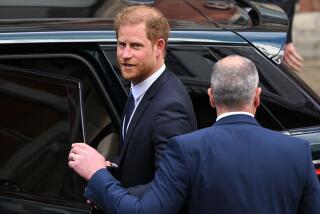36 to Name Prince of Knights of Malta : Oldest Chivalric Order to Pick New Sovereign
ROME — In the early years of the 12th Century, a holy man named Gerard founded a hospital in Jerusalem to care for Christian pilgrims felled by the rigors of their journey.
Next week, Gerard’s knightly heirs gather here, in solemn and secret conclave, to elect a blueblood sovereign for history’s oldest chivalric order and the world’s smallest state. As in Gerard’s time, their principal concern is in caring for “our lords, the sick.”
Like history sprung to life, the election of His Most Eminent Highness Prince and Grand Master of the Sovereignty of the Military Hospitalier Order of St. John of Jerusalem of Rhodes and of Malta will be held in a locked conference room in a palace on the Aventine Hill overlooking Rome.
No more than three ballots. No lobbying, no polling, no handicapping. No public or private mention of the winner until, the order’s constitution requires, Pope John Paul II ratifies his knights’ choice.
“It is not like American politics, where candidates present their programs. Here the electors will choose the man they judge will be best in carrying out the order’s program,” said Msgr. Antonio Jannone, spokesman for the order best known as the Knights of Malta.
Swords Checked at Door
The 36 electors will check their swords at the conclave door, although since a ruling in 1259 by Pope Alexander IV, knights are authorized to wear swords in church as defenders of the faith. The bygone military tradition is almost as old as the healing ethic for the Knights of Malta, which maintains around 200 medical facilities in some 90 countries, according to Jannone.
Of the electors dressed in 13th-Century red military uniforms with cocked hats and a black cape with a distinctive white Maltese cross, 22 Europeans are eligible to become sovereign to replace the late Angelo de Mejana di Cologna, an Italian elected in 1962. As required, all 22 potential grandmasters can trace noble lineage on both sides of their families for at least 200 years.
Two of the electors are Americans. One, interim order leader Giancarlo Pallavicini, is a Hungarian aristocrat of Italian descent who studied biochemistry at Columbia University and worked at the National Institutes of Health in Washington. The other is businessman J. Peter Grace, representing the 62-year-old New York-based American Assn. of Knights. The order also has associations in Washington and San Francisco.
The knights’ flag, a white cross on a field of red approved by Pope Innocent II in 1130, will fly over the conclave as it does each day on the Aventine and atop a 16th-Century palace on the Via Condotti in Rome that is the order’s headquarters.
The Italian government recognizes both palaces as extraterritorial, the same status accorded the Vatican. The order, born in the Holy Land during the Crusades with other storied religious military orders like the Knights Templars and the Order of Teutonic Knights, successively controlled Rhodes and Malta until Napoleonic times. The Mediterranean island of Malta now is an independent republic.
Today, the two palaces in Rome are all the territory the Knights of Malta has left, but the order has diplomatic ties with more than 36 countries, including Somalia and Cuba, issues passports that are recognized by about 50 countries, including the United States, and issues stamps that are accepted as valid postage by 32 countries, but not the United States.
The diplomatic recognition is the order’s pride--but sometimes also a source of embarrassment. Last fall, an Italian businessman who was the Knights of Malta charge d’affaires in Cuba disclosed that he had worked for 12 years as a double agent for Cuban intelligence and the CIA.
Although originally restricted to nobles, the order’s government officials are all still aristocrats. But about 60% of the order’s 10,000 members worldwide are now just plain folk.
“Opening the order to active Catholics who are non-nobles has enabled us to increase our activities. We are more democratic, but the tradition is the same as ever,” said Felice Catalano, an Italian diplomat and aristocrat who functions as the order’s prime minister.
After Italy, with 2,870 members, the United States has the largest contingent, 2,350. National associations finance their own activities at home and sometimes also abroad. In the United States, the order’s charity includes clinics at St. Vincent Medical Center in Los Angeles and Providence Hospital in Oakland, as well as a family clinic in East Los Angeles and homes for the aged in Oakland and San Francisco.
Prominent American Catholics awaiting election of their order’s new leader include former Secretary of State Alexander M. Haig Jr., auto maker Lee A. Iacocca and Washington attorney Edward Bennett Williams. The late CIA Director William J. Casey also was a member.
More to Read
Sign up for The Wild
We’ll help you find the best places to hike, bike and run, as well as the perfect silent spots for meditation and yoga.
You may occasionally receive promotional content from the Los Angeles Times.






